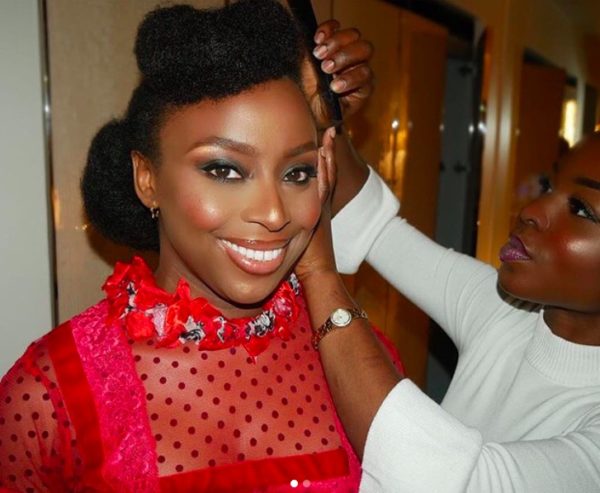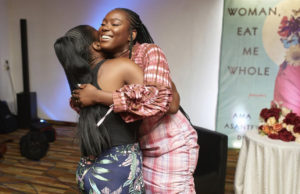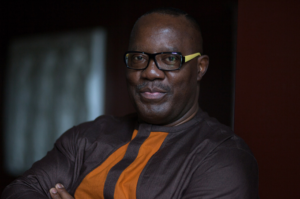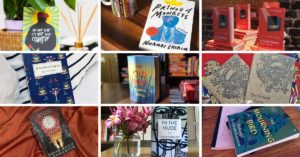
Fashion and style have traditionally being the cultural domain of pop-stars. It’s a sphere of influence that public intellectuals have typically kept at arm’s length or skirted around with the utmost care. If you’re known as someone who has smart, authoritative things to say about society, there is always the risk that appearing to care about makeup or red carpets or bespoke blazers could delegitimize your standing in some way.
But African writers have had no problem breaking this stereotype of the public intellectual. Alain Mabanckou is known for his impossibly dapper style. Teju Cole loves his Ikire Jones scarves, which he would sometimes wear like a super-hero cape. But Chimamanda Adichie has been the most vocal about the joys and contradictions of exploring the intersections between a public intellectual life and a love for fashion.
Ever since the 2014 elle.com article [here] and the feature in Fashion Bomb Daily [here], Adichie has maintained a clear stance on uniting the domains of fashion and intellectual culture. She has been open about her thoughts on what it’s like being a fashionista, a novelist, and a figure of feminist ideals and politics. With memorable quotes like “your love of fashion doesn’t have to be a metaphor for the consciousness of multiple metaphysical selves or something. Your love of fashion can just be your love of fashion,” Adichie has translated style and fashion in terms that many women find relatable and inspiring.
In a piece titled “My Fashion Nationalism,” published recently on The Financial Times, she further explores her interest in fashion. The essay, peppered with images drawn from her Instagram page, is a short history of her love affair with fashion. She takes the reader through a timeline that begins with her teenage years, passes through her brief stint at the University of Nigeria where she won the “Best Dressed Girl” award, and ends with her new role on Instagram as a self-appointed ambassador of the Nigerian fashion industry.
The essay is a thoughtful reflection on the evolution of personal style. It briefly documents her journey to becoming a fashion inspiration to over 90,000 Instagram followers. We have selected some of the most inspiring moments in the essay, hoping it would serve as inspiration to our readers.
If Chimamanda Adichie’s journey to becoming an Instagram fashion star has taught us anything, it is the fact that style, like any other mode of self-expression, requires passion, honesty, and attention to detail.
1. Find a fashion icon
My much-older sisters, Ijeoma and Uche, were stylish figures, one in medical school and the other studying pharmacy, and I spent my teenage years wearing their hand-me-downs. I remember a silver-coloured skirt suit from the conservative Ijeoma, with an elegantly adult peplum. I wore it to church at 15. And from the more inventive Uche, a fitted dress in cream jersey, two sashes draped in front, from shoulder to hip, crossing at the middle. And black harem trousers, with ruching that gathered at my calves, so strange that my classmates giggled when I wore them to a friend’s birthday party. I loved those clothes, incongruous though they might have been. In them, I felt free of self-consciousness, comfortable enough to laugh along to the well-meaning puzzlement of my peers.
2. It’s Okay To Be Misunderstood. It’s Called Originality.
When I studied medicine for a year at the University of Nigeria, Nsukka I was voted “Best Dressed Girl”. A classmate said: “Congratulations, even though you wear some things that I don’t understand.” I laughed. Perhaps he meant the green crochet top and black bell-bottom trousers I had found in my mother’s old trunk from the 1960s. I was drawn to clothes that were slightly unusual, quietly quirky, as long as they never sank to the level of costume.
3. Wear What You Like!
If I had a style mantra it was to wear what I liked. Yet when I moved to the US to attend college, I began to wear clothes I disliked. My fiction was getting published, I was keen to be taken seriously, and I had noticed the backward treatment of women in western culture: women interested in clothes or make-up were labelled frivolous, their intelligence became suspect, and they risked being easily dismissed in intellectual circles. So I wore what I imagined would make me look worthy of seriousness.
4. Always Read Between the Lines of Fashion Industry Cliché’s
I began to resist some standard ideas and language of global — which is to say narrowly western — fashion. The depiction of bright colours as bold or daring, black as the unimpeachable hallmark of sophistication, and beige as neutral, for example, were based on a specific pale-skinned standard. For a dark-skinned person, blue might be a better black, brighter colours more ordinary than daring, and neutral negotiable.
My greatest gripe was with the word “modest”, used to describe clothes for what they were not — short or body-baring — rather than for what they were. “Modest” brought a moral, frumpy taint to what was often an aesthetic choice. I loved midi lengths because I found them sexy, sleeves because they were more flattering, higher necklines for their air of confident chic.
5. Don’t Be Afraid to Let Your Fashion Mix With Your Politics
I designed my own clothes, and my tailor, Razak, made them in Lagos. Razak was talented and distracted and unreliable. He was also convinced that he was an undiscovered music star. It was 2016 and Nigeria’s economy was in chaos. President Buhari’s government had instituted a retrograde currency policy, the value of the naira plummeted, and suddenly everyone was talking about “buy Nigerian products to grow the naira”.
The political rhetoric gave me an idea: what if I wore only Nigerian designers to public events? I would be supporting the different layers of the industry, from the button-sewer to the delivery person, and I hoped to bring other buyers to Nigerian brands.
*********
Photos from Chimamanda Adichie’s instagram page.









COMMENTS -
Reader Interactions